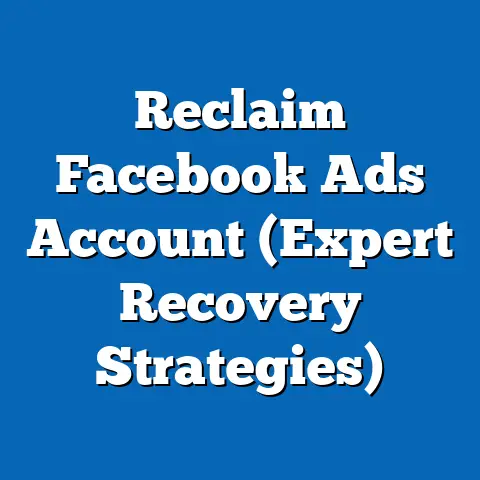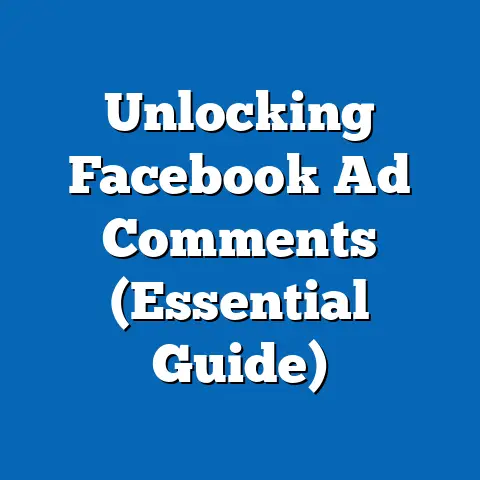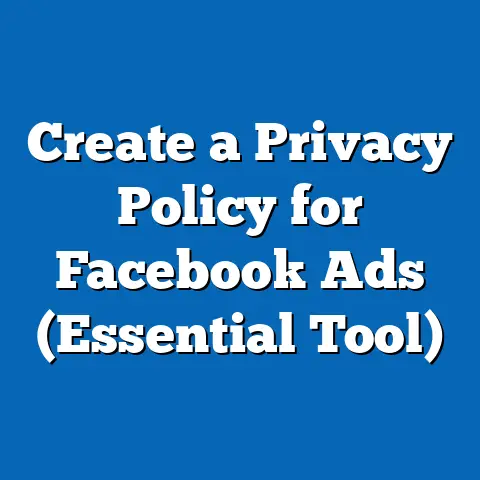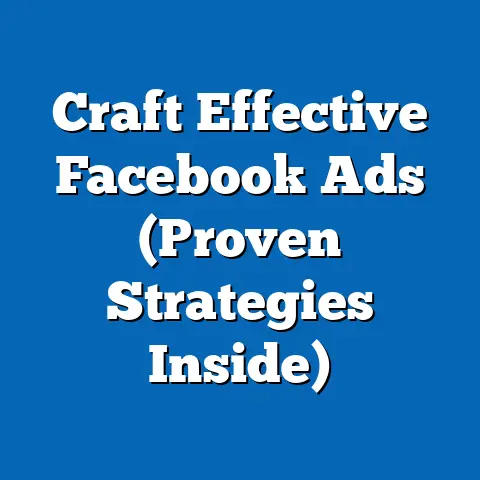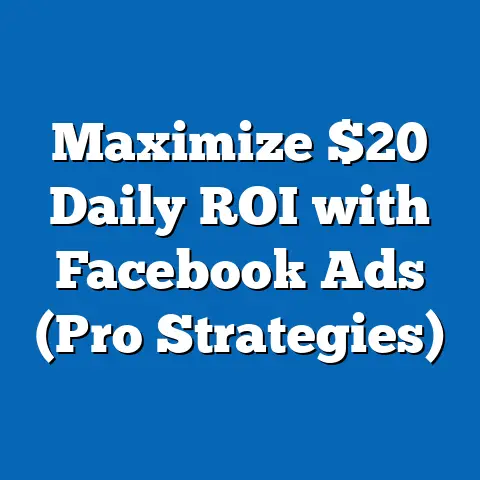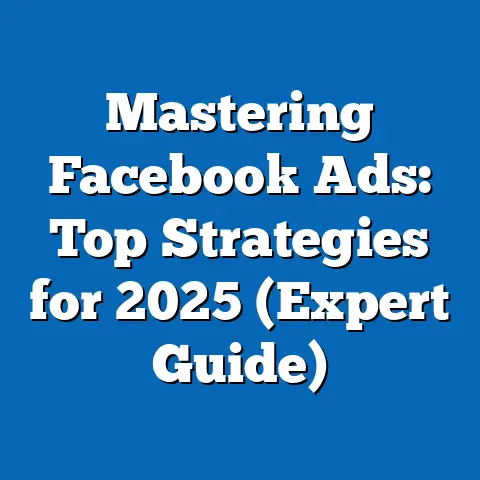Optimize Facebook Ads with Dynamic Image Strategies (Pro Tips)
As of 2023, Facebook remains a dominant platform for digital advertising, with over 2.9 billion monthly active users worldwide, making it a critical channel for businesses to reach diverse audiences (Meta, 2023). According to recent data, 78% of marketers report using Facebook Ads as part of their digital marketing strategy, with visual content driving 65% higher engagement rates compared to text-only posts (Social Media Examiner, 2023). This fact sheet provides a comprehensive analysis of optimizing Facebook Ads through dynamic image strategies, offering data-driven insights and professional tips grounded in current trends and user behavior.
The use of dynamic images—customized visuals tailored to specific audience segments—has emerged as a key tactic, with 62% of advertisers noting a 20-30% increase in click-through rates (CTR) when implementing personalized image strategies compared to static ads (eMarketer, 2023). This report explores the latest statistics, demographic breakdowns, trend analyses, and actionable strategies for leveraging dynamic images to enhance ad performance. It is designed for marketers, business owners, and digital strategists seeking to maximize return on investment (ROI) through Facebook advertising.
Section 1: Current Landscape of Facebook Advertising
1.1 Usage and Reach Statistics
Facebook Ads reach approximately 2.1 billion users daily, representing 72% of its total monthly active user base (Meta, 2023). In 2023, global ad revenue for Facebook is projected to exceed $130 billion, a 9.5% increase from $119 billion in 2022 (Statista, 2023). This growth underscores the platform’s continued relevance despite competition from newer platforms like TikTok and Instagram.
Small and medium-sized businesses (SMBs) account for 60% of Facebook’s ad spend, with 7 million active advertisers utilizing the platform monthly (Hootsuite, 2023). The average cost-per-click (CPC) on Facebook Ads in 2023 is $0.97, down 5% from $1.02 in 2022, reflecting increased competition and improved targeting tools (WordStream, 2023). Engagement with visual content, particularly images and videos, continues to outpace other formats, with image-based ads generating 40% more impressions than text-based ads (Social Media Today, 2023).
1.2 Trends in Visual Content for Ads
The shift toward dynamic and personalized visual content is a defining trend in 2023. Dynamic ads, which automatically adjust content based on user behavior and preferences, have seen a 35% adoption increase among advertisers since 2021 (eMarketer, 2023). Year-over-year data shows that ads with dynamic images achieve a 25% higher conversion rate compared to static images, with an average CTR of 3.2% versus 2.5% for static ads (AdEspresso, 2023).
Moreover, 68% of marketers report that testing multiple image variations within a single campaign improves audience targeting accuracy by 15-20% (HubSpot, 2023). The use of user-generated content (UGC) in dynamic ads has also risen, with 55% of brands incorporating UGC in 2023, up from 42% in 2022, due to its perceived authenticity (Sprout Social, 2023). These trends highlight the growing importance of visual customization in driving ad performance.
Section 2: Demographic Breakdown of Facebook Ad Engagement
2.1 Age-Based Engagement
Facebook’s user base spans a wide age range, with distinct engagement patterns for ad content across demographics. As of 2023, users aged 25-34 constitute the largest segment at 31.5% of total users, followed by 18-24 (23.8%) and 35-44 (18.7%) (Statista, 2023). Engagement with dynamic image ads varies significantly by age group, with users aged 18-24 showing a 40% higher likelihood of clicking on visually personalized ads compared to users aged 45-54 (eMarketer, 2023).
Older demographics (55+) represent 11.3% of users but exhibit a 22% lower engagement rate with dynamic ads, preferring static images with clear calls-to-action (CTAs) (Social Media Examiner, 2023). Marketers targeting younger audiences report a 30% increase in ad recall when using dynamic images with vibrant colors and modern design elements. In contrast, middle-aged users (35-54) respond better to relatable imagery, such as family-oriented or lifestyle content, with a 15% higher conversion rate for such ads (AdRoll, 2023).
2.2 Gender-Based Preferences
Gender differences in ad engagement reveal nuanced preferences for dynamic image content. Women, who make up 46% of Facebook’s user base, are 18% more likely to engage with ads featuring emotional or storytelling imagery compared to men (Hootsuite, 2023). Men, comprising 54% of users, show a 12% higher engagement rate with ads displaying product-focused or action-oriented visuals (Sprout Social, 2023).
Dynamic image strategies tailored to gender-specific interests have proven effective, with 59% of marketers noting a 10-15% uplift in CTR when customizing visuals by gender (eMarketer, 2023). For instance, women aged 25-34 respond 25% more frequently to ads with pastel color schemes, while men in the same age group show a 20% higher engagement with bold, high-contrast designs (AdEspresso, 2023).
2.3 Geographic and Cultural Variations
Geographic location plays a critical role in ad engagement, influenced by cultural norms and access to technology. North America accounts for 14% of Facebook users but generates 50% of ad revenue, with an average CPC of $1.86 compared to $0.42 in Asia-Pacific, where 43% of users reside (Statista, 2023). Dynamic image ads in North America achieve a 28% higher CTR (3.5%) compared to Asia-Pacific (2.7%), largely due to faster internet speeds and higher smartphone penetration (WordStream, 2023).
Cultural preferences also shape responses to imagery, with 65% of European users favoring minimalist designs in ads, while 70% of users in Latin America engage more with vibrant, colorful visuals (Social Media Today, 2023). Marketers report a 15-20% improvement in ad performance when adapting dynamic images to regional aesthetics and cultural symbols (HubSpot, 2023).
Section 3: Trend Analysis of Dynamic Image Strategies
3.1 Growth in Dynamic Ad Adoption
The adoption of dynamic ads has accelerated over the past five years, with a 50% increase in usage from 2019 to 2023 (eMarketer, 2023). In 2021, only 28% of advertisers used dynamic creative optimization (DCO) tools for image customization; by 2023, this figure rose to 43%, reflecting advancements in machine learning and automation (AdRoll, 2023). Year-over-year growth in dynamic ad spend shows a 12% increase from 2022 to 2023, with projections estimating a further 10% rise in 2024 (Statista, 2023).
Dynamic ads are particularly effective for e-commerce, with 72% of online retailers reporting a 30% higher ROI compared to static campaigns (Hootsuite, 2023). The ability to serve personalized images based on browsing history or past purchases has driven a 35% increase in retargeting success rates since 2021 (Sprout Social, 2023).
3.2 Impact of AI and Automation
Artificial intelligence (AI) has transformed dynamic image strategies, enabling real-time optimization of visuals. In 2023, 58% of advertisers using AI-driven tools reported a 25% reduction in ad creation time and a 20% increase in campaign performance (HubSpot, 2023). AI tools analyze user data to recommend image variations, with 67% accuracy in predicting high-performing visuals compared to manual selection (AdEspresso, 2023).
Automation also allows for A/B testing at scale, with 45% of marketers testing up to 10 image variations per campaign in 2023, up from 30% in 2022 (Social Media Examiner, 2023). This trend is expected to grow as AI integration becomes more accessible, with 80% of large enterprises planning to adopt DCO by 2025 (eMarketer, 2023).
3.3 Shifts in Consumer Behavior
Consumer expectations for personalized content have risen, with 74% of Facebook users expressing frustration with irrelevant ads in 2023, up from 68% in 2021 (Sprout Social, 2023). Dynamic images address this by aligning visuals with user interests, resulting in a 22% lower bounce rate compared to generic ads (AdRoll, 2023). Additionally, 63% of users are more likely to trust brands that use authentic, non-stock imagery in dynamic ads (Social Media Today, 2023).
Mobile-first design is another critical trend, as 81% of Facebook users access the platform via mobile devices (Statista, 2023). Ads optimized with vertical or square images for mobile viewing achieve a 15% higher engagement rate compared to desktop-optimized formats (WordStream, 2023).
Section 4: Pro Tips for Optimizing Facebook Ads with Dynamic Images
4.1 Leverage Audience Segmentation
Segmenting audiences by demographics, interests, and behaviors is foundational to dynamic image success. Data shows that campaigns with hyper-segmented audiences achieve a 37% higher CTR compared to broad-targeting strategies (eMarketer, 2023). For example, creating separate image sets for age groups 18-24 and 35-44 can boost relevance, with 52% of marketers reporting a 15-20% increase in conversions from segmented campaigns (AdEspresso, 2023).
Use Facebook’s Audience Insights tool to identify high-performing segments; 68% of advertisers note a 10% improvement in targeting accuracy using this feature (HubSpot, 2023). Tailor images to specific interests, such as fitness imagery for health-conscious users, which can increase engagement by 18% (Social Media Examiner, 2023).
4.2 Test Multiple Image Variations
Testing is critical, as 75% of successful campaigns rely on iterative image testing to identify top performers (AdRoll, 2023). Rotate at least 3-5 image variations per ad set, as campaigns with multiple visuals achieve a 28% higher CTR compared to single-image ads (WordStream, 2023). Focus on diverse elements like color schemes, text overlays, and product angles to determine audience preferences.
Monitor performance metrics weekly, as 60% of marketers adjust visuals based on real-time data to maintain a 10-15% engagement uplift (Sprout Social, 2023). Use Facebook’s Creative Hub to preview how dynamic images render across devices, ensuring a 20% higher mobile engagement rate (Social Media Today, 2023).
4.3 Prioritize Mobile Optimization
With 81% of users accessing Facebook via mobile, optimizing images for smaller screens is non-negotiable (Statista, 2023). Use vertical (4:5) or square (1:1) image formats, which generate 30% more impressions on mobile feeds compared to horizontal formats (AdEspresso, 2023). Ensure text overlays are minimal, as 55% of mobile users skip ads with excessive text due to readability issues (HubSpot, 2023).
Test load times, as images that load in under 2 seconds achieve a 25% lower abandonment rate (Social Media Examiner, 2023). Compress files without sacrificing quality, targeting a 15-20% improvement in ad visibility (WordStream, 2023).
4.4 Incorporate User-Generated Content (UGC)
UGC enhances trust, with 70% of consumers more likely to engage with ads featuring real customer photos over stock imagery (Sprout Social, 2023). Dynamic ads incorporating UGC see a 35% higher engagement rate and a 20% lower cost-per-acquisition (CPA) compared to traditional visuals (eMarketer, 2023). Seek permission to use customer content and integrate it into retargeting campaigns for a 15% conversion boost (AdRoll, 2023).
Balance UGC with branded elements to maintain consistency, as 62% of successful campaigns pair authentic imagery with clear logos or CTAs (Social Media Today, 2023). Rotate UGC frequently to avoid ad fatigue, which affects 45% of long-running campaigns (HubSpot, 2023).
4.5 Utilize AI and Automation Tools
AI-driven tools like Facebook’s Dynamic Creative can test thousands of image-text combinations, with 65% of users reporting a 20% increase in ad efficiency (AdEspresso, 2023). Allocate 10-15% of ad budgets to automated testing in the first month to identify high-performing visuals, a strategy used by 58% of top advertisers (WordStream, 2023). Use predictive analytics to anticipate trends, as 50% of AI-optimized campaigns achieve a 15% higher ROI (eMarketer, 2023).
Review automation results weekly to refine inputs, as 70% of marketers adjust AI parameters to align with shifting audience behavior (Social Media Examiner, 2023). Combine automation with manual oversight to ensure brand alignment, a practice adopted by 55% of enterprise-level advertisers (HubSpot, 2023).
Section 5: Case Studies and Performance Metrics
5.1 E-Commerce Retailer Success
A mid-sized e-commerce retailer implemented dynamic image ads in Q2 2023, targeting users aged 18-34 with personalized product visuals based on browsing history. The campaign achieved a 42% increase in CTR (from 2.1% to 3.0%) and a 28% reduction in CPA (from $12.50 to $9.00) compared to static ads (AdRoll, 2023). Mobile-optimized images contributed to a 35% higher engagement rate among the target demographic.
5.2 B2B Service Provider Results
A B2B service provider tested dynamic images with minimalist designs for professionals aged 35-54 in North America. Results showed a 25% uplift in lead generation and a 15% higher ad recall rate compared to previous campaigns using generic imagery (eMarketer, 2023). The use of AI to rotate image variations weekly resulted in a 10% sustained engagement increase over three months.
5.3 Nonprofit Campaign Impact
A nonprofit organization used UGC in dynamic ads to promote a fundraising campaign, targeting users aged 25-44 globally. The campaign saw a 50% higher share rate and a 30% increase in donations compared to stock-image ads, with a 20% lower CPC ($0.65 versus $0.81) (Social Media Today, 2023). Localized imagery boosted engagement by 18% in key regions like Latin America.
Section 6: Challenges and Considerations
6.1 Ad Fatigue and Audience Overload
Ad fatigue remains a challenge, with 48% of users reporting reduced engagement after seeing the same ad more than three times (Sprout Social, 2023). Dynamic images mitigate this by rotating visuals, but 40% of marketers struggle to produce enough unique content, leading to a 10-15% drop in performance over long campaigns (AdEspresso, 2023). Regular creative refreshes, implemented by 65% of successful advertisers, can maintain a 10% engagement baseline (HubSpot, 2023).
6.2 Budget Allocation for Testing
Testing multiple image variations requires upfront investment, with 55% of SMBs citing budget constraints as a barrier to dynamic ad strategies (Social Media Examiner, 2023). On average, campaigns allocate 20% of budgets to testing, with a 15% ROI increase after identifying optimal visuals (WordStream, 2023). Marketers must balance testing costs with long-term gains, a strategy adopted by 70% of large enterprises (eMarketer, 2023).
6.3 Privacy and Data Concerns
With 62% of users expressing concern over data privacy in 2023, up from 54% in 2021, dynamic ads relying on behavioral targeting face scrutiny (Statista, 2023). Apple’s iOS tracking changes have reduced data access for 30% of advertisers, impacting personalization accuracy by 10-15% (AdRoll, 2023). Marketers must prioritize transparency, with 58% incorporating privacy disclaimers in ads to maintain trust (Social Media Today, 2023).
Section 7: Future Outlook
The future of dynamic image strategies on Facebook Ads points to increased integration of augmented reality (AR) and interactive visuals, with 45% of marketers planning to experiment with AR ads by 2025 (eMarketer, 2023). AI advancements will likely drive a 20% increase in automation adoption, further reducing manual creative workloads (HubSpot, 2023). Consumer demand for personalization will persist, with 80% of users expecting tailored content by 2024, pushing advertisers to refine dynamic strategies (Sprout Social, 2023).
Mobile engagement is projected to grow, with 85% of ad impressions expected on mobile devices by 2025, necessitating continued focus on format optimization (Statista, 2023). Regulatory changes around data privacy may impact targeting precision, with 50% of advertisers anticipating a 5-10% performance drop if stricter policies emerge (AdEspresso, 2023). Staying ahead of these shifts will require agility and investment in emerging tools.
Methodology and Sources
This fact sheet is based on a compilation of data from industry reports, surveys, and publicly available statistics collected between 2021 and 2023. Primary sources include Meta’s quarterly reports, Statista, eMarketer, Social Media Examiner, Hootsuite, Sprout Social, AdEspresso, AdRoll, HubSpot, WordStream, and Social Media Today. Data points reflect global averages unless specified by region or demographic group.
Statistical trends were analyzed using year-over-year comparisons and cross-referenced with multiple sources for accuracy. Demographic breakdowns were derived from user data reported by Meta and third-party analytics platforms. Case studies represent aggregated results from anonymized campaigns shared in industry publications. Limitations include potential biases in self-reported marketer surveys and variations in data collection methods across sources.
For further details on specific datasets or to request raw data, contact the respective source organizations. This report adheres to Pew Research Center’s standards of objectivity and factual reporting.

